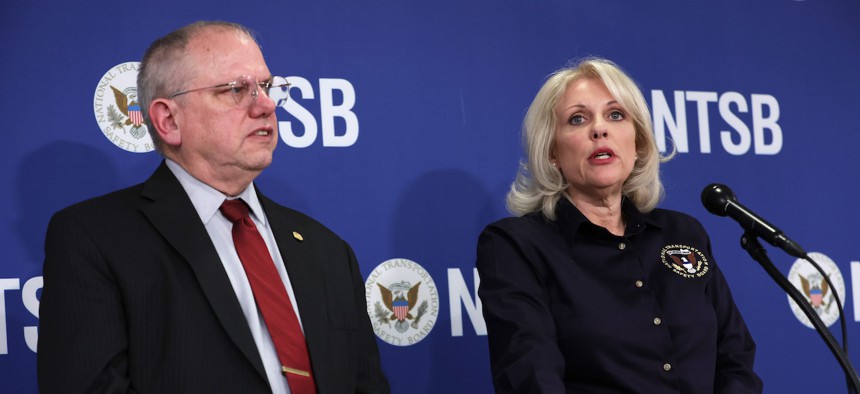
Jennifer Homendy, chair of the National Transportation Safety Board, speaks as Robert Hall, director of the NTSB’s Office of Railroad, Pipeline and Hazardous Materials, listens during a news briefing on the East Palestine Northern Southern freight train derailment on Feb. 23, 2023, at the agency’s headquarters. Despite limited resources, NTSB is failing to make plans and track progress in a way that would allow for maximum efficiency, according to the Government Accountability Office. Alex Wong/Getty Images
A small transportation safety agency is struggling to keep pace with growing responsibilities
Faced with “extremely limited resources" and the same staffing level it had 20 years ago, the NTSB is trying to do more with less.
The federal board tasked with investigating transportation accidents and recommending safety improvements is struggling to keep pace with its growing list of responsibilities, according to a new report and the agency’s own admissions.
The National Transportation Safety Board has about 400 employees, the same number it had 20 years ago. Technological advances and general growth in the transportation sector has put more on the agency's plate in the intervening time, which, according to a new Government Accountability Office report, is "straining NTSB’s ability to keep pace." It took the agency 19 months to complete an investigation on average in 2016, but that grew to 22 months in 2020. Despite limited resources, the auditors said, NTSB is failing to make plans and track progress in a way that would allow for maximum efficiency.
GAO noted that transportation is becoming increasingly complex, citing the increased use of drones and automated vehicles. NTSB must ensure its workforce have the appropriate skills, the auditors said, but is failing to identify gaps in its workforce. The agency does not maintain any list of the skillsets of its current employees and GAO recommended it conduct surveys and listening sessions to better determine those.
“NTSB has recently taken steps to determine whether its workforce has the skills needed to carry out the agency’s mission,” GAO said. “However, these efforts do not provide comprehensive information on the skills staff need, how many staff have those skills, and where skill gaps exist.”
In deciding whether to investigate an incident, NTSB determines both how high of a priority the issue is based on transferability of the lessons learned and whether it has the staff availability and capacity. In the five-year period beginning in fiscal 2017, NTSB conducted more than 8,300 total investigations, 96% of which were for aviation accidents. It has engaged in high-profile train accidents this year, most notably in East Palestine, Ohio.
NTSB has properly described external factors that could impact their goals and plans for achieving unmet goals. GAO cited NTSB, however, for failing to come up with strategic goals that lay out specifically how the agency will improve transportation safety. Its annual performance goals were not quantifiable or measurable, the auditors said. NTSB officials acknowledged the limitations of its approach, but blamed its data systems for preventing more detailed analysis. GAO said the agency should make better use of the data it does maintain, such as on implementation of its safety recommendations and its investigation timelines.
Congress appropriated just $129 million to NTSB in fiscal 2023 and therefore, GAO said, the agency must take great pains to maximize every dollar it spends. Without more mission-focused plans accompanied by measurable goals, NTSB risks spending its limited resources in an inefficient manner.
In a recent proposal to Congress to reauthorize the agency, NTSB itself acknowledged it is struggling to keep pace with increasing demands. The growth of the transportation system, as well as investments in new types of transportation infrastructure, presents "great opportunities for improving safety," said Jennifer Homendy, NTSB chair, but also "safety challenges." The measure outlined by agency leadership would provide a 12% funding increase for the agency in fiscal 2024 and steady boosts for the following four years. It would require a human capital plan to address both short and long-term needs, and provide direct hire authority to the agency for the next three years.
“The draft bill, if implemented, will improve our ability to carry out critical safety mission now and in the future; to recruit, retain and develop a highly qualified, specialized, diverse and inclusive workforce; to prepare the agency for investigations involving emerging transportation technologies and systems; and to meet existing needs and future challenges through data-driven decision-making and cross-office risk management," Homendy said.
The agency also said it is taking internal steps to address GAO’s concerns, including by hiring a chief data scientist in 2018 and a chief data officer this year. It is also standardizing its processes across all of its investigation types. It has launched a database to house information on its investigations and provide a system for managing workflow.
In response to the report, Homendy again stressed her agency is faced with “extremely limited resources.” She said the agency is making significant progress in becoming more efficient, noting it has decreased the number of investigative reports more than two years old from its peak of 442 in early 2022 to near zero today. Complying with all of GAO recommendations to improve its goal-setting process, she said, would require additional funding.
Congress last authorized NTSB in 2018 along with the Federal Aviation Administration. Lawmakers are once again in the process of reauthorizing FAA—and NTSB along with it—though bipartisan bills in the House and Senate are currently in dispute between the two chambers. The House version, which the House Transportation and Infrastructure Committee approved unanimously in July, would provide the same initial 12% cash injection for the agency, but follow that with much smaller increases. It would allow the agency to use direct hiring for any position with a critical need.







